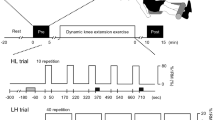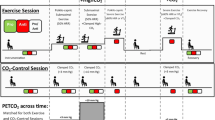Abstract
Cerebral blood flow (CBF) increases from rest to ∼60% of peak oxygen uptake (VO2peak) and thereafter decreases towards baseline due to hyperventilation-induced hypocapnia and subsequent cerebral vasoconstriction. It is unknown what happens to CBF in older adults (OA), who experience a decline in CBF at rest coupled with a blunted ventilatory response during VO2peak. In 14 OA (71 ± 10 year) and 21 young controls (YA; 23 ± 4 years), we hypothesized that OA would experience less hyperventilation-induced cerebral vasoconstriction and therefore an attenuated reduction in CBF at VO2peak. Incremental exercise was performed on a cycle ergometer, whilst bilateral middle cerebral artery blood flow velocity (MCA V mean; transcranial Doppler ultrasound), heart rate (HR; ECG) and end-tidal PCO2 (PETCO2) were monitored continuously. Blood pressure (BP) was monitored intermittently. From rest to 50% of VO2peak, despite greater elevations in BP in OA, the change in MCA V mean was greater in YA compared to OA (28% vs. 15%, respectively; P < 0.0005). In the YA, at intensities >70% of VO2peak, the hyperventilation-induced declines in both PETCO2 (14 mmHg (YA) vs. 4 mmHg (OA); P < 0.05) and MCA V mean (−21% (YA) vs. −7% (OA); P < 0.0005) were greater in YA compared to OA. Our findings show (1), from rest-to-mild intensity exercise (50% VO2peak), elevations in CBF are reduced in OA and (2) age-related declines in hyperventilation during maximal exercise result in less hypocapnic-induced cerebral vasoconstriction.


Similar content being viewed by others
References
Ainslie PN, Duffin J (2009) Integration of cerebrovascular CO2 reactivity and chemoreflex control of breathing: mechanisms of regulation, measurement, and interpretation. Am J Physiol Regul Integr Comp Physiol 5:R1473–R1495
Ainslie PN, Tzeng YC (2010) On the regulation of the blood supply to the brain: old age concepts and new age ideas. J Appl Physiol 108:1447–1449
Ainslie PN, Cotter JD, George KP, Lucas S, Murrell C, Shave R, Thomas KN, Williams MJ, Atkinson G (2008) Elevation in cerebral blood flow velocity with aerobic fitness throughout healthy human ageing. J Physiol 16:4005–4010
Beason-Held LL, Moghekar A, Zonderman AB, Kraut MA, Resnick SM (2007) Longitudinal changes in cerebral blood flow in the older hypertensive brain. Stroke 6:1766–1773
Borg G (1970) Perceived exertion as an indicator of somatic stress. Scand J Rehab Med 2:92–98
Brys M, Brown CM, Marthol H, Franta R, Hilz MJ (2003) Dynamic cerebral autoregulation remains stable during physical challenge in healthy persons. Am J Physiol Heart Circ Physiol 3:H1048–H1054
Buijs PC, Krabbe-Hartkamp MJ, Bakker CJ, de Lange EE, Ramos LM, Breteler MM, Mali WP (1998) Effect of age on cerebral blood flow: measurement with ungated two-dimensional phase-contrast MR angiography in 250 adults. Radiology 3:667–674
Cassaglia PA, Griffiths RI, Walker AM (2009) Cerebral sympathetic nerve activity has a major regulatory role in the cerebral circulation in REM sleep. J Appl Physiol 4:1050–1056
Chen HI, Kuo CS (1989) Relationship between respiratory muscle function and age, sex, and other factors. J Appl Physiol 2:943–948
Fagius J, Wallin BG (1993) Long-term variability and reproducibility of resting human muscle nerve sympathetic activity at rest, as reassessed after a decade. Clin Auton Res 3:201–205
Fisher JP, Ogoh S, Young CN, Raven PB, Fadel PJ (2008) Regulation of middle cerebral artery blood velocity during dynamic exercise in humans: influence of aging. J Appl Physiol 1:266–273
Fleg JL (1986) Alterations in cardiovascular structure and function with advancing age. Am J Cardiol 5:33C–44C
Franklin SS, Gustin W, Wong ND, Larson MG, Weber MA, Krannel WB, Levy D (1997) Hemodynamic patterns of age-related changes in blood pressure: The Framingham Heart Study. Circulation 1:308–315
Gribbin B, Pickering TG, Sleight P, Peto R (1971) Effect of age and high blood pressure on baroreflex sensitivity in man. Circ Res 4:424–431
Heckmann JG, Brown CM, Cheregi M, Hilz MJ, Neundorfer B (2003) Delayed cerebrovascular autoregulatory response to ergometer exercise in normotensive elderly humans. Cerebrovasc Dis 4:423–429
Hellstrom G, Fischer-Colbrie W, Wahlgren NG, Jogestrand T (1996) Carotid artery blood flow and middle cerebral artery blood flow velocity during physical exercise. J Appl Physiol 1:413–418
Jones N, Robertson D, Kane J (1979) Difference between end-tidal and arterial PCO2 in exercise. J Appl Physiol 5:954–960
Jorgensen LG, Perko G, Secher NH (1992) Regional cerebral artery mean flow velocity and blood flow during dynamic exercise in humans. J Appl Physiol 5:1825–1830
Kashimada A, Machida K, Honda N, Mamiya T, Takahashi T, Kamano T, Inoue Y, Osada H (1994) Measurement of cerebral blood flow in normal subjects by phase contrast MR imaging. Nippon Igaku Hoshasen Gakkai Zasshi 12:1116–1125
Kashimada A, Machida K, Honda N, Mamiya T, Takahashi T, Kamano T, Osada H (1995) Measurement of cerebral blood flow with two-dimensional cine phase-contrast mR imaging: evaluation of normal subjects and patients with vertigo. Radiat Med 2:95–102
Kronenberg RS, Drage CW (1973) Attenuation of the ventilatory and heart rate responses to hypoxia and hypercapnia with aging in normal men. J Clin Invest 8:1812–1819
Luckhaus C, Cohnen M, Fluss MO, Janner M, Grass-Kapanke B, Teipel SJ, Grother M, Hampel H, Peters O, Komhuber J, Maier W, Supprian T, Gaebel W, Modder U, Wittsack HJ (2010) The relation of regional cerebral perfusion and atrophy in mild cognitive impairment (MCI) and early Alzheimer’s dementia. Psychiatry Res 1:44–51
Madsen PL, Sperling BK, Warming T, Schmidt JF, Secher NH, Wildschiodtz G, Holm S, Lassen NA (1993) Middle cerebral artery blood velocity and cerebral blood flow and O2 uptake during dynamic exercise. J Appl Physiol 1:245–250
Mittman C, Edelman N, Norris A, Shock N (1965) Relationship between chest wall and pulmonary compliance and age. J Appl Physiol 6:1211–1216
Moraine JJ, Lamotte M, Berre J, Niset G, Leduc A, Naeije R (1993) Relationship of middle cerebral artery blood flow velocity to intensity during dynamic exercise in normal subjects. Eur J Appl Physiol Occup Physiol 1:35–38
Nybo L, Rasmussen P (2007) Inadequate cerebral oxygen delivery and central fatigue during strenuous exercise. Exerc Sport Sci Rev 3:110–118
Ogoh S, Ainslie PN (2009) Regulation mechanism of cerebral blood flow during exercise: new concepts. Exerc Sport Sci Rev 3:123–129
Ogoh S, Dalsgaard M, Yoshiga C, Dawson E, Keller D, Raven P, Secher NH (2005a) Dynamic cerebral autoregulation during exhaustive exercise in humans. Am J Physiol Heart Circ Physiol 3:1461–1462
Ogoh S, Fadel PJ, Zhang R, Selmer C, Jans O, Secher NH, Raven PB (2005b) Middle cerebral artery flow velocity and pulse pressure during dynamic exercise in humans. Am J Physiol Heart Circ Physiol 4:H1526–H1531
Ogoh S, Hayashi N, Inagaki M, Ainslie PN, Miyamoto T (2008) Interaction between the ventilatory and cerebrovascular response to hypo- and hypercapnia at rest and during exercise. J Physiol 586:4327–4338
Olin JT, Dimmen AC, Subudhi AW, Roach RC (2010) Cerebral blood flow and oxygenation at maximal exercise: the effect of clamping carbon dioxide. Respir Physiol Neurobiol 1:176–180
Panerai RB, Dawson SL, Potter JF (1999) Linear and nonlinear analysis of human dynamic cerebral autoregulation. Am J Physiol 3:H1089–H1099
Paulson OB, Strandgaard S, Edvinsson L (1990) Cerebral autoregulation. Cerebrovasc Brain Metab Rev 2:161–192
Peebles K, Celi L, McGrattan K, Murrell C, Thomas K, Ainslie PN (2007) Human cerebrovascular and ventilatory CO2 reactivity to end-tidal, arterial and internal jugular vein PCO2. J Physiol 584:347–357
Peterson DD, Pack AI, Silage DA, Fishman AP (1981) Effects of aging on ventilatory and occlusion pressure responses to hypoxia and hypercapnia. Am Rev Respir Dis 4:387–391
Poels MM, Ikram MA, Vemooij MW, Krestin GP, Hofman A, Niessen WJ, van der Lugt A, Breteler MM (2008) Total cerebral blood flow in relation to cognitive function: the Rotterdam Scan Study. J Cereb Blood Flow Metab 28:1652–1655
Pott F, Jensen K, Hansen H, Christensen NJ, Lassen NA, Secher NH (1996) Middle cerebral artery blood velocity and plasma catecholamines during exercise. Acta Physiol Scand 4:349–356
Querido JS, Sheel AW (2007) Regulation of cerebral blood flow during exercise. Sports Med 9:765–782
Rowell LB (1993) Human cardiovascular control. Oxford University Press, New York
Scheel P, Ruge C, Petruch UR, Schoning M (2000) Color duplex measurement of cerebral blood flow volume in healthy adults. Stroke 1:147–150
Sidney KH, Shephard RJ (1977) Maximum and submaximum exercise tests in men and women in the seventh, eighth, and ninth decades of life. J Appl Physiol 2:280–287
Stoquart-ElSankari S, Baledent O, Gondry-Jouet C, Makki M, Godefroy O, Meyer ME (2007) Aging effects on cerebral blood and cerebrospinal fluid flows. J Cereb Blood Flow Metab 9:1563–1572
Thomas KN, Cotter JD, Galvin SD, Williams MJ, Willie CK, Ainslie PN (2009) Initial orthostatic hypotension is unrelated to orthostatic tolerance in healthy young subjects. J Appl Physiol 2:506–517
Turner JM, Mead J, Wohl ME (1968) Elasticity of human lungs in relation to age. J Appl Physiol 6:664–671
Tzeng YC, Lucas SJ, Atkinson G, Willie CK, Ainslie PN (2010) Fundamental relationships between arterial baroreflex sensitivity and dynamic cerebral autoregulation in humans. J Appl Physiol 5:1162–1168
van Beek AH, Claassen JA, Rikkert MG, Jansen RW (2008) Cerebral autoregulation: an overview of current concepts and methodology with special focus on the elderly. J Cereb Blood Flow Metab 6:1071–1085
Wasserman K (1987) Determinants and detection of anaerobic threshold and consequences of exercise above it. Circulation 6:129–139
Willie CK, Colino FL, Bailey DM, Tzeng YC, Binsted G, Jones LW, Haykowsky MJ, Bellapart J, Ogoh S, Smith KJ, Smirl JD, Day TA, Lucas SJ, Eller LK, Ainslie PN (2011) Utility of transcranial Doppler ultrasound for the integrative assessment of cerebrovascular function. J Neurosci Meth 2:221–237
Yam AT, Lang EW, Lagopoulos J (2005) Cerebral autoregulation and ageing. J Clin Neurosci 6:643–646
Acknowledgements
We appreciate the time and effort by all the volunteer subjects. This project was funded in part by NSERC and CIHR.
Author information
Authors and Affiliations
Corresponding author
About this article
Cite this article
Marsden, K.R., Haykowsky, M.J., Smirl, J.D. et al. Aging blunts hyperventilation-induced hypocapnia and reduction in cerebral blood flow velocity during maximal exercise. AGE 34, 725–735 (2012). https://doi.org/10.1007/s11357-011-9258-9
Received:
Accepted:
Published:
Issue Date:
DOI: https://doi.org/10.1007/s11357-011-9258-9




